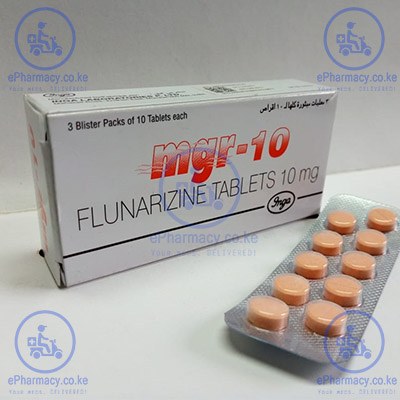Description
Flunarizine is given by mouth as the hydrochloride although doses are expressed in terms of the equivalent amount of flunarizine. Flunarizine hydrochloride 11.8 mg is approximately equivalent to 10 mg of flunarizine. The usual dose is 5 to 10 mg daily, usually given at night to minimize the effects of drowsiness.
Migraine.
Flunarizine reduces the frequency of migraine attacks in both adult and paediatric patients and is used for the prophylaxis of migraine in some countries including Kenya. Its effects are comparable with several other prophylactic antimigraine drugs, including those generally preferred, pizotifen and propranolol,
but it is more likely to be reserved for use when first-line drugs have proved to be ineffective or unsuitable. Its mode of action in migraine is unclear; possible mechanisms are inhibition of vasospasm induced by mediators such as serotonin and prostaglandins, inhibition of cellular hypoxia, and improved blood viscosity and erythrocyte deformability. Calcium-channel blocking activity might have a role, but evidence for the efficacy of other calcium-channel blockers in migraine prophylaxis (see Nifedipine, is less convincing than for flunarizine.
Case reports have indicated benefit with flunarizine in the prophylaxis of the rare disorder of alternating hemiplegia in childhood5,6 but a subsequent study7 in 12 children did not produce conclusive findings. A later long-term study8 reported that 7 of 9 children given flunarizine for up to 5 years for hemiplegia showed a reduction in the duration of attacks, and 3 had a reduction in frequency, but only 1 of these obtained a complete cessation of episodes.
Adverse effects also seen with flunarizine include weight gain, extrapyramidal symptoms (sometimes associated with depression), and, rarely, galactorrhoea.
Extrapyramidal disorders.
Extrapyramidal motor signs (including parkinsonism, orofacial tardive dyskinesia, and akathisia) have been reported in 12 patients given flunarizine 10 to 40 mg daily for between 3 weeks and 15 months; 11 also had mental depression.1 Partial or complete improvement of symptoms occurred after withdrawal of flunarizine. There have been other reports of similar effects,2-4 but the association with flunarizine has not always been certain. Some workers have commented that flunarizine is often used in patients at increased risk of depression (migraine and geriatric patients) or extrapyramidal symptoms (geriatric patients)2,5
It has been suggested that such effects may be less likely to occur with cinnarizine than with flunarizine because of its shorter half-life and lower lipophilicity.3






Reviews
There are no reviews yet.